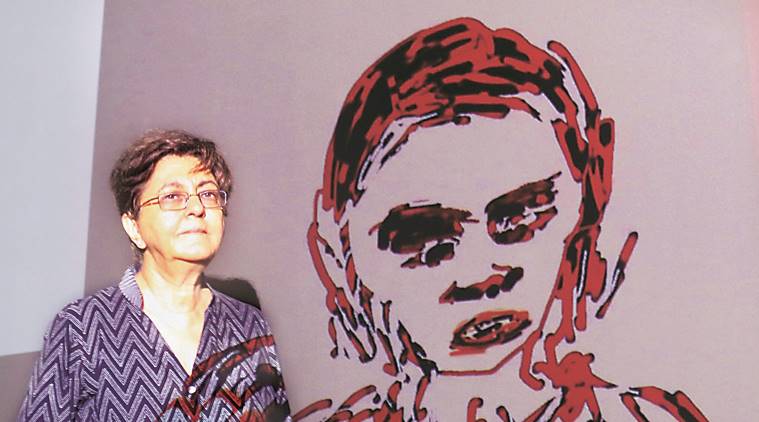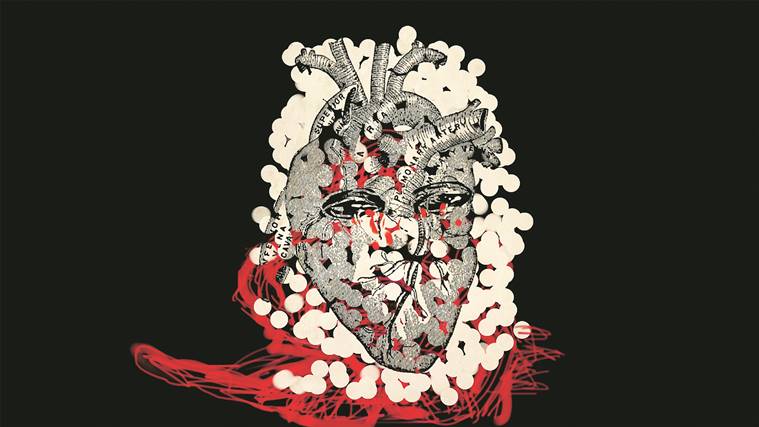- India
- International
‘The rise in the price of art doesn’t reflect its quality’
In the backdrop of her latest solo in Mumbai, veteran artist Nalini Malani talks about her works, and pushing the boundaries of art.
 Nalini Malani at the exhibition. (Express photo by Ganesh Shirsekar)
Nalini Malani at the exhibition. (Express photo by Ganesh Shirsekar)
Stepping inside the gallery at Mumbai’s Max Mueller Bhavan to see Nalini Malani’s first solo in recent years, ‘Can You Hear Me?’, we are immediately plunged into darkness; sounds, both industrial and shriek-like, wash over the space. On each of the walls, running from one end of the room to the other, over 50 animations flash furiously at regular intervals. It’s chaotic, visceral, uncomfortable, but the Mumbai-based artist has no intention of being otherwise — the show is a response to a question and a command. If ‘Can You Hear Me?’ is a scream from a minor girl who was violently raped, whose cries went unheard, then ‘Can You Hear Me’ is all about power exerted by the government, capitalistic forces, armies and class systems over those who cannot speak out. At the gallery, Malani talks about her works, old and new, pushing the boundaries of what is art, and where can it exist. Excerpts:
When one enters the gallery, it’s as though they are sitting inside your mind — they have a ringside view to your thoughts.
These animations are like thought bubbles; they started as pages of a digital notebook in 2018. Whenever I see or read something that captures my imagination, I need to react with a drawing or drawings in motion. Not exactly in its mimetic form but more as a ‘memory emotion’. Whether it was something in the news or a poem, such as Nothing Twice by the Polish poet Wislawa Szymborska, where she writes, ‘Nothing can ever happen twice. In consequence, the sorry fact is that we arrive here improvised and leave without the chance to practice’.
But in the course of the history, we do see that things happen twice, or thrice.
Some events may seem the same, but our reactions to them are different. For example, in 1974, we tested the nuclear device; we did it in 1997 too. That year, a news channel called me up to ask, ‘as an artist, what do you think?’ I said that I would put my answer into an artwork. It became the multi-channel video installation, Remembering Toba Tek Singh, which was shown in 1999 at the Chhatrapati Shivaji Maharaj Vastu Sangrahalaya and attracted more than 25,000 visitors. The dialogues between the visitors were different in 1974. So many people expressed their concern about what will happen with a nuclear fallout in either of the countries, especially for the children. The clouds cannot be divided.

 Mephisto by Nalini Malani
Mephisto by Nalini Malani
A lot of the animations in this show speak of the brutalities faced by disenfranchised peoples — farmers, Dalits, Kashmiris and women.
People whose voices will never be heard…when I read about them, I think why couldn’t we stop that? When I feel the suffering of other people, the only way out is to be farcical, satirical or absurd in my art. Somehow or the other, we’re unable to do things collectively. A sorry state — as if we’ve become a caste upon ourselves.
Tell us about Dream Houses, the animation you did in 1969, being exhibited in Mumbai for the first time. The play of light and colour is deceptively simple but it really does bring the urban landscape to life in a few minutes.
Back then, I’d just finished at the JJ School of Art, and Akbar Padamsee had started the interdisciplinary collective VIEW (Vision Exchange Workshop) that summer and invited me to join. Besides a series of camera-less photographs, I made a labour-intensive stop-motion animation film called Dream Houses that summer. It is about the idealism and hope of the Nehruvian period of a modern India in which poverty and housing problems could be solved through a masterplan for urban space. I worked every day for nearly two months. Each acetate sheet was shot separately with an 8 mm film camera with different colour filters, and each segment of the film was reversed inside the camera and exposed twice or thrice. Dream Houses thus became a colour fantasy of a utopian urban landscape. As a 23-year-old artist, I had no financial means to make this reverse stock version into a screening copy. It, therefore, remained in a tin box for almost 50 years, till it was digitally scanned and is now acquired by several international museums.
With your animations, you’ve been open to mediums. From the maquette to the photoplays to your iPad work, which you’ve made freely available on Instagram, have you been cocking a snook at the art establishment?
My interest in making art available on a non-commercial scale to a wider public started in 1991 with making artist books on photocopied pages, and using the Gallery Chemould space in 1992 for making a wall drawing, or as a newspaper at the time wrote, ‘impermanent sight-specific installation’. These iPad animations are an extension of this. iPad Pro, and more specifically, an animation app and Garage Band give me the opportunity to create animations and the sound design that I could place in social media. That way people get to see original artwork for free. The rise in the price of art is not a reflection of its quality. Art has its own value — it’s priceless, in fact.
 Phantoms in the Head by Nalini Malani
Phantoms in the Head by Nalini Malani
In taking art out of their mainstream confines, what has that taught you about the way your work has been received all these years?
Now that I am 73, I see clearly that each generation has its own rhythm in visual language. In the absurd and frenetic time, we are living in, it is refreshing and heartening to see this language that I developed of overlapping animation video projections strike a chord, especially with young people. I hope that I can still do this with a new art format for the next generation when I turn 90.
The exhibition is on till January 2, 2020
Apr 26: Latest News
- 01
- 02
- 03
- 04
- 05




































